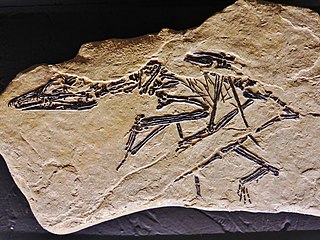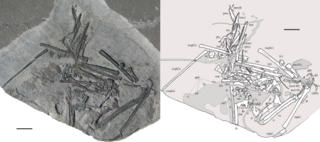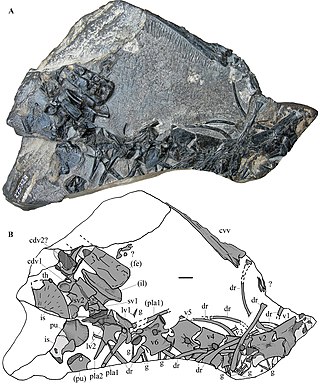
Eudimorphodon was a pterosaur that was discovered in 1973 by Mario Pandolfi in the town of Cene, Italy and described the same year by Rocco Zambelli. The nearly complete skeleton was retrieved from shale deposited during the Late Triassic, making Eudimorphodon one of the oldest pterosaurs known. It had a wingspan of about 100 centimeters (3.3 ft) and at the end of its long bony tail may have been a diamond-shaped flap like in the later Rhamphorhynchus. If so, the flap may have helped it steer while maneuvering in the air. Eudimorphodon is known from several skeletons, including juvenile specimens.

Preondactylus is a genus of long-tailed pterosaurs from the Late Triassic that inhabited what is now Italy. It contains a single known species, Preondactylus buffarinii, which was discovered by Nando Buffarini in 1982 at the Forni Dolostone near Udine in the Preone valley of the Italian Alps.

Peteinosaurus was a prehistoric genus of pterosaur. It lived in the late Triassic period in the late Norian age, and at a wingspan of around 60 cm (24 in), was one of the smallest and earliest pterosaurs, although other estimates suggest a wingspan of up to 1 m (3.3 ft).

Austriadactylus is a genus of "rhamphorhynchoid" pterosaur. The fossil remains were unearthed in Late Triassic rocks of Austria.
Caviramus is a genus of caviramid pterosaur from the Late Triassic lower Kössen Formation of the Northern Calcareous Alps of Switzerland.

Megalancosaurus is a genus of extinct reptile from the Late Triassic Dolomia di Forni Formation and Zorzino Limestone of northern Italy, and one of the best known drepanosaurids. The type species is M. preonensis; a translation of the animal's scientific name would be "long armed reptile from the Preone Valley."

Raeticodactylus is a genus of non-pterodactyloid pterosaur from the late Norian-early Rhaetian-age Upper Triassic lower Kössen Formation of the central Austroalpine of Grisons, Switzerland. It is known from holotype BNM 14524, a single disarticulated partial skeleton including an almost complete skull, found in August 2005. This genus was named and described in 2008 by its discoverer Rico Stecher; the type species is Raeticodactylus filisurensis. The specific name refers to Filisur.
Langobardisaurus is an extinct genus of tanystropheid archosauromorph reptile, with one known species, L. pandolfii. Its fossils have been found in Italy and Austria, and it lived during the Late Triassic period, roughly 228 to 201 million years ago. The Langobardisaurus was first discovered by Italian paleontologist Silvio Renesto in 1994 from the Calcare di Zorzino Formation in Northern Italy.
Bobosaurus is an extinct genus of sauropterygian reptile related to plesiosaurs. It is based on the holotype MFSN 27285, a partial skeleton found in Early Carnian-age rocks of the Rio del Lago Formation, northeastern Italy. Bobosaurus was named in 2006 by Fabio M. Dalla Vecchia and the type species is B. forojuliensis. It may be a pistosaurid, or closer to Plesiosauria. A recent cladistic analysis found it to be a pistosaur. It was relatively large animal, with more than 3 m (9.8 ft) in length.
The Forni Dolostone, also known as the Dolomia di Forni, is a Late Triassic dolomite geological formation in northeastern Italy. The formation was deposited in a lagoonal to shallow marine environment.

Carniadactylus is a genus of pterosaur which existed in Europe during the Late Triassic period. The genus contains a single species, Carniadactylus rosenfeldi.
Faxinalipterus is a genus of ornithodiran archosaur, originally described as a pterosaur, from the Late Triassic Caturrita Formation of southern Brazil. A study from 2022 reinterpreted the fossil remains and instead suggests them to belong to a member of the Lagerpetidae, a more basal clade of pterosauromorph.

Eopterosauria is a group of basal pterosaurs from the Triassic, which form their own clade. The term was first used in Andres et al. (2014) to include Preondactylus, Austriadactylus, Peteinosaurus and Eudimorphodontidae. Inside the group were two other new clades, Preondactylia, which included Preondactylus and Austriadactylus, and Eudimorphodontoidea, to include Eudimorphodontidae and Raeticodactylidae. Eopterosauria was defined as "the least inclusive clade containing Preondactylus buffarinii and Eudimorphodon ranzii". The specimen BSP 1994, previously assigned to Eudimorphodon, was named the separate taxon Austriadraco in 2015, and assigned to the new family Austriadraconidae, but further classification was not described. The following phylogenetic analysis follows the topology of Andres et al. (2014).

Tholodus is an extinct genus of basal ichthyopterygian known from the Middle Triassic of Germany, northeastern Italy and possibly China. It was first named by Christian Erich Hermann von Meyer in 1851 and the type species is Tholodus schmidi. It is known from many disarticulated and fragmentary remains, mainly teeth and jaw fragments. Most specimens were collected from various localities across the Ladinian-aged Muschelkalk, Germany, mainly from the Jena Formation of the upper Lower Muschelkalk, where the holotype was found. Dalla Vecchia (2004) recently described two additional specimens, a mandibular ramus and a maxilla, both bearing teeth and nearly uncrushed, and some postcranial remains, from a single late Anisian outcrop, from the southern Alps of Italy. The humerus resembled that of immature individuals of the Asian genus Chaohusaurus, suggesting possible affinities to Grippidia.
Austriadraco is a genus of pterosaur living during the Late Triassic in the area of present Austria. Its only species—Austriadraco dallavecchiai—was previously attributed to Eudimorphodon, and its closest relatives may have been Eudimorphodon or Arcticodactylus.

Bergamodactylus is a putative genus of basal pterosaur which lived during the Late Triassic in the area of present-day Bergamo province in Italy. Its only species is Bergamodactylus wildi. It was named in 2015 based on a pterosaur specimen which had previously been regarded as a juvenile Eudimorphodon or as identical to Carniadactylus. Some Triassic pterosaur specialists consider the distinguishing features of Bergamodactylus to be invalid or insufficient to distinguish it from Carniadactylus, and thus retain the specimen in that genus.

Caelestiventus is a pterosaur genus from the Late Triassic found in western North America. The type species, Caelestiventus hanseni, honors Robin Hansen, the Bureau of Land Management geologist (BLM), who facilitated access to the excavation site.

Seazzadactylus is a basal pterosaur genus that during the late Triassic lived in the area of present Italy.

Raibliania is an extinct genus of tanystropheid archosauromorph discovered in the Calcare del Predil Formation in Italy. It lived during the Carnian stage of the Late Triassic and it was related to Tanystropheus. Raibliania is distinct from Tanystropheus due to some distinct features of the cervical vertebrae and teeth. The type species is Raibliania calligarisi, named in 2020. The holotype consists of a partial post-cranial skeleton, with the known elements including vertebrae, a single tooth, several ribs, gastralia and parts of the pelvis.

Heteropelta is an extinct genus of archosauriform, possibly a basal archosauriform, basal phytosaur or a suchian archosaur. It is known from a single species, Heteropelta boboi, which was found in the Middle Triassic Torbiditi d’Aupa Formation in Italy. The holotype is listed as specimen MFSN 46485 and was collected after 2006.













